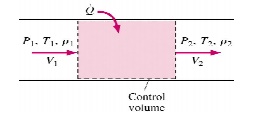Chapter: Mechanical : Gas Dynamics and Jet Propulsion : Flow Through Ducts
Rayleigh Flow (Duct Flow with Heat Transfer and Negligible Friction)
Rayleigh Flow (Duct Flow
with Heat Transfer and Negligible Friction)
Flow in a constant area duct with heat
transfer and without friction is known as Rayleigh flow . Many compressible
flow problems encountered in practice involve chemical reactions such as
combustion, nuclear reactions, evaporation, and condensation as well as heat
gain or heat loss through the duct wall Such problems are difficult to analyze
Essential features of such complex flows can be captured by a simple analysis
method where generation/absorption is modeled as heat transfer through the wall
at the same rate

In
certain engineering processes, heat is added either by external sources across
the system boundary by heat exchangers or internally by chemical reactions in a
combustion chamber. Such process are not truely adiabatic, they are called
adiabatic processes.
Ø Applications
The
combustion chambers inside turbojet engines usually have a constant area and
the fuel mass addition is negligible. These properties make the Rayleigh flow
model applicable for heat addition to the flow through combustion, assuming the
heat addition does not result in dissociation of the air-fuel mixture.
Producing a shock wave inside the combustion chamber of an engine due to
thermal choking is very undesirable due to the decrease in mass flow rate and
thrust. Therefore, the Rayleigh flow model is critical for an initial design of
the duct geometry and combustion temperature for an engine.
The Rayleigh flow model is also used
extensively with the Fanno flow model. These two models intersect at points on
the enthalpy-entropy and Mach number-entropy diagrams, which is meaningful for
many applications. However, the entropy values for each model are not equal at
the sonic state. The change in entropy is 0 at M = 1 for each model, but the
previous statement means the change in entropy from the same
arbitrary point to the sonic
point is different for the Fanno and Rayleigh flow models.
Ø Combustion
processes.
Ø Regenerator,
Ø Heat
exchangers.
Ø Inter
coolers.
The
following are the assumptions that are made for analyzing the such flow
problem.
Ø One
dimensional steady flow.
Ø Flow
takes place in constant area duct.
Ø The
frictional effects are negligible compared to heat transfer effects..
Ø The
gas is perfect.
Ø Body
forces are negligible.
Ø There
is no external shaft work.
Ø There
is no obstruction in the flow.
Ø There
is no mass addition or rejection during the flow.
Ø The
composition of the gas doesn’t change appreciably during the flow.
Related Topics